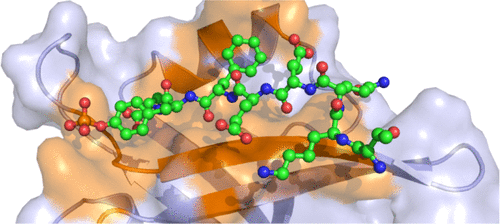当前位置:
X-MOL 学术
›
J. Chem. Inf. Model.
›
论文详情
Our official English website, www.x-mol.net, welcomes your
feedback! (Note: you will need to create a separate account there.)
Improving Sequence-Based Prediction of Protein–Peptide Binding Residues by Introducing Intrinsic Disorder and a Consensus Method
Journal of Chemical Information and Modeling ( IF 5.6 ) Pub Date : 2018-06-12 00:00:00 , DOI: 10.1021/acs.jcim.8b00019 Zijuan Zhao 1 , Zhenling Peng 1 , Jianyi Yang 2
Journal of Chemical Information and Modeling ( IF 5.6 ) Pub Date : 2018-06-12 00:00:00 , DOI: 10.1021/acs.jcim.8b00019 Zijuan Zhao 1 , Zhenling Peng 1 , Jianyi Yang 2
Affiliation

|
Protein–peptide interaction is crucial for many cellular processes. It is difficult to determine the interaction by experiments as peptides are often very flexible in structure. Accurate sequence-based prediction of peptide-binding residues can facilitate the study of this interaction. In this work, we developed two novel sequence-based methods SVMpep and PepBind to identify the peptide-binding residues. Recent studies demonstrate that the protein–peptide binding is closely associated with intrinsic disorder. We thus introduced intrinsic disorder in our feature design and developed the ab initio method SVMpep. Experiments show that intrinsic disorder contributes to 1.2–5.2% improvement in area under the receiver operating characteristic curve (AUC). Comparison to the recent sequence-based method SPRINT-Seq reveals that SVMpep improves the AUC and Matthews correlation coefficient (MCC) by at least 7.7% and 70%, respectively. In addition, by combining SVMpep with two template-based methods S-SITE and TM-SITE, we next proposed the consensus-based method PepBind. Remarkably, compared with the latest structure-based method SPRINT-Str, PepBind improves the AUC and MCC by 1.7% and 28.3%, respectively, on the same independent test set of SPRINT-Str. The success of PepBind is attributed to the improved prediction of the ab initio method SVMpep by introducing intrinsic disorder and the consensus prediction by combining three complementary methods. A web server that implements the proposed methods is freely available at http://yanglab.nankai.edu.cn/PepBind/.
中文翻译:

通过引入内在障碍和共识方法改善基于序列的蛋白质-肽结合残基的预测。
蛋白质-肽相互作用对于许多细胞过程至关重要。由于肽通常在结构上非常灵活,因此难以通过实验确定相互作用。基于序列的肽结合残基的准确预测可以促进这种相互作用的研究。在这项工作中,我们开发了两种新颖的基于序列的方法SVMpep和PepBind来识别肽结合残基。最近的研究表明,蛋白质-肽结合与内在疾病密切相关。因此,我们在功能设计中引入了内在障碍,并开发了从头开始方法SVMpep。实验表明,在接收机工作特性曲线(AUC)下,内在的无序有助于面积增加1.2-5.2%。与最近的基于序列的方法SPRINT-Seq的比较表明,SVMpep分别将AUC和Matthews相关系数(MCC)分别提高了至少7.7%和70%。此外,通过将SVMpep与两种基于模板的方法S-SITE和TM-SITE结合,我们接下来提出了基于共识的方法PepBind。值得注意的是,与最新的基于结构的方法SPRINT-Str相比,PepBind在相同的独立测试集上将AUC和MCC分别提高了1.7%和28.3%。PepBind的成功归因于从头计算的改进预测方法SVMpep通过引入内在障碍和共识预测相结合的三种互补方法。实现上述方法的Web服务器可从http://yanglab.nankai.edu.cn/PepBind/免费获得。
更新日期:2018-06-12
中文翻译:

通过引入内在障碍和共识方法改善基于序列的蛋白质-肽结合残基的预测。
蛋白质-肽相互作用对于许多细胞过程至关重要。由于肽通常在结构上非常灵活,因此难以通过实验确定相互作用。基于序列的肽结合残基的准确预测可以促进这种相互作用的研究。在这项工作中,我们开发了两种新颖的基于序列的方法SVMpep和PepBind来识别肽结合残基。最近的研究表明,蛋白质-肽结合与内在疾病密切相关。因此,我们在功能设计中引入了内在障碍,并开发了从头开始方法SVMpep。实验表明,在接收机工作特性曲线(AUC)下,内在的无序有助于面积增加1.2-5.2%。与最近的基于序列的方法SPRINT-Seq的比较表明,SVMpep分别将AUC和Matthews相关系数(MCC)分别提高了至少7.7%和70%。此外,通过将SVMpep与两种基于模板的方法S-SITE和TM-SITE结合,我们接下来提出了基于共识的方法PepBind。值得注意的是,与最新的基于结构的方法SPRINT-Str相比,PepBind在相同的独立测试集上将AUC和MCC分别提高了1.7%和28.3%。PepBind的成功归因于从头计算的改进预测方法SVMpep通过引入内在障碍和共识预测相结合的三种互补方法。实现上述方法的Web服务器可从http://yanglab.nankai.edu.cn/PepBind/免费获得。











































 京公网安备 11010802027423号
京公网安备 11010802027423号